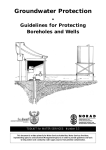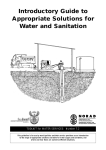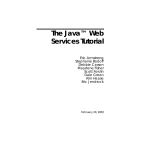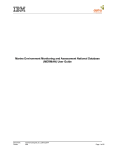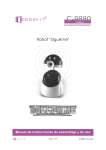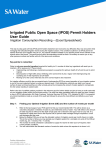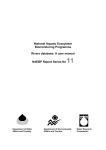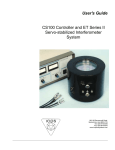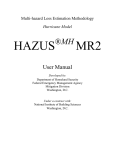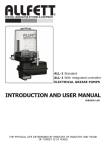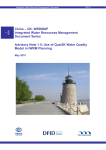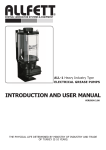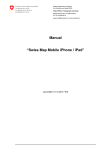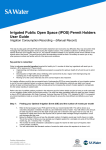Download Groundwater Monitoring for Pump Operators
Transcript
Groundwater Monitoring for Pump Operators TOOLKIT for WATER SERVICES: Number 6.1 This document is a guideline for pump operators who need to monitor groundwater. The document is primarily intended for Water Services Providers and their staff. Groundwater Monitoring for Pump Operators © DWAF, March 2004 Published by Department of Water Affairs and Forestry Directorate: Information Programmes Private Bag X313 PRETORIA 0001 Republic of South Africa Tel: (012) 336 7500 This publication may be reproduced only for non-commercial purposes and only after appropriate authorisation by the Department of Water Affairs and Forestry has been provided. No part of this publication may be reproduced in any manner without full acknowledgement of the source. Implemented by CSIR Written by Phillip Ravenscroft and Ricky Murray Editing Anthea Josias Artwork Vusi Malindi Layout and design Gill McDowell Inputs Eddy van Wyk Produced under: The NORAD-Assisted Programme for the Sustainable Development of Groundwater Sources under the Community Water and Sanitation Programme in South Africa Foreword Toolkit for Water Services Groundwater has historically been given limited attention, and has not been perceived as an important water resource, in South Africa. This is reflected in general statistics showing that only 13 % of the nation’s total water supply originate from groundwater. However, because of the highly distributed nature of the water demand in rural and informal peri-urban settlements, regional schemes are, in most instances, not economically feasible. And because of generally increasing water scarcity and decreasing available river and spring flows during low flow and drought periods, as well as wide-spread problems of surface water pollution in rural areas, groundwater will be the most feasible option for a large part of the new water demand. Already it is estimated that over sixty percent of community water supply is from groundwater, making it a strategically important resource. The NORAD-Assisted Programme for the Sustainable Development of Groundwater Sources under the Community Water and Sanitation Programme in South Africa was managed by the Department of Water Affairs and Forestry (DWAF) between 2000 and 2004. The Programme undertook a series of inter-related projects aimed at enhancing capacity of water services authorities and DWAF to promote and implement sustainable rural water supply schemes based on groundwater resources and appropriate technologies. Page 2 has a full list of the Programme outputs. The formats for these range from documents to software programmes and an internet portal, to reference sites where communities have implemented appropriate technologies. For more information on the “package” of Programme outputs contact your nearest DWAF Regional Office or Head Office in Pretoria. It is our sincere hope that this Programme will contribute to the body of work that exists to enable more appropriate use and management of groundwater in South Africa. Grounwater Monitoring for Pump Operators is Number 6.1 in the Toolkit for Water Services. This document is a reference manual primarily for pump operators who need to monitor groundwater. The document is intended for Water Services Providers and their staff. 1 Groundwater Monitoring for Pump Operators Toolkit for Water Services 1 1.1 1.2 Overview documentation A Framework for Groundwater Management of Community Water Supply Implementing a Rural Groundwater Management System: a step-by-step guide 2 2.1 Descriptors Standard Descriptors for Geosites 3 3.1 3.2 3.3 3.4 3.4.1 3.4.2 3.4.3 3.4.4 3.4.5 3.4.6 3.4.7 Groundwater Protection Involving community members in a hydrocensus Guidelines for protecting springs Guidelines for protecting boreholes and wells Guidelines on protecting groundwater from contamination Animal kraals, watering points and dipping tanks Burial sites Informal vehicle servicing, spray painting and parts washing facilities Pit latrines Runoff water Subsistence agriculture Informal waste disposal 4 4.1 Maps Thematic Groundwater Maps 5 5.1 5.1.1 5.1.2 5.1.3 5.1.4 5.2 5.2.1 5.3 5.3.1 Software Sustainability Indexing Tool (SusIT) SusIT User Guide SusIT Field Data Capturer’s User Manual SusIT Questionnaire SusIT Information Brochure AquiMon Management System AquiMon Information Brochure Geohydrological Data Access System (GDAS) GDAS Information Brochure 6 Monitoring 6.1 Groundwater Monitoring for Pump Operators 7 7.1 7.2 7.3 Sustainability Sustainability Best Practices Guidelines for Rural Water Services Introductory Guide to Appropriate Solutions for Water and Sanitation Decision Making Framework for Municipalities 8 8.1 8.2 8.3 Reference Sites Genadendal Information Brochure Kammiesberg Information Brochure Maputaland Information Brochure 2 Groundwater Monitoring for Pump Operators Table of Contents Foreword 2 Toolkit for Water Services 3 Acronyms 4 1 Groundwater Monitoring What is groundwater and why do we monitor it? The role of the pump operator in monitoring groundwater 5 5 6 2 Measuring Water Levels Introduction Equipment required for measuring the water level Step by step – measuring the water level Cleanliness Safety 7 7 7 9 12 12 3 Measuring the Amount or Volume of Water Pumped: Taking a Flow-meter Measurement 13 4 Recording Readings in Your Logbook Manual operated pumps Automatic pumps General – for both manual and automatic pumps 14 14 15 16 5 The Borehole Commonly used pumps Switches used on automatic pumps 17 17 19 6 Sample Evaluation Form for Pump Attendants – Groundwater Monitoring 22 7 References and additional reading 23 8 Glossary and definitions 24 Acronyms CMA Catchment Management Agency CWSS Community Water Supply and Sanitation DWAF Department of Water Affairs and Forestry O&M Operation and Maintenance SSA Support Services Agent WRM Water Resource Management WSA Water Services Authority WSDP Water Services Development Plan WSP Water Services Provider 4 Groundwater Monitoring for Pump Operators 1 Groundwater Monitoring What is groundwater and why do we monitor it? Groundwater is water that is found below the surface of the earth in the small cracks and spaces found in the rocks and sand underground. Groundwater originally comes from rain that has soaked into the ground over large areas, and is stored underground like a large sponge filled with water. Naturally, springs are found where this underground water overflows onto the surface of the earth. Boreholes are holes drilled deep into the rock formations below the earth’s surface. By using a pump installed inside a borehole, water can be pumped from this underground sponge for people to use. We monitor groundwater by recording how much water we have used and by recording the level of the water under the ground. The purpose of monitoring groundwater is to be able to know how much water is available for use and if it is suitable for drinking. When we pump water from a borehole, the water level underground drops, as shown in the illustration. Diagram 1: Groundwater levels before and during pumping Before pumping spring borehole rest water level During pumping borehole water level during pumping 5 Groundwater Monitoring for Pump Operators The role of the pump operator in monitoring groundwater 1 The pump operator is a vital link in the groundwater monitoring chain. The pump operator records the level of the water in the borehole and the amount of water that has been pumped. The pump operator also notes any problems or changes that they may have noticed with the borehole and the pump. 2 This information is sent to the Water Services Authority (WSA) where it is entered into the computer groundwater management system. 3 Reports from this system are supplied to the WSA technical staff, who analyse the data. From this analysis, they will see if the borehole is being over-pumped or under-pumped and may make recommendations to the pump operator to change the way that the borehole is being operated. The WSA technical staff may also ask a specialist groundwater expert for advice on some of the information. 4 The information collected by the WSA is used for reporting to DWAF Hydrological Services. They are responsible for looking after all the groundwater in South Africa. If the pump operator does not keep good records, all these other people (the WSA, DWAF, etc.) are unable to do their jobs in managing groundwater. This guideline document focuses on what is needed for the pump operator to keep good records. Diagram 2: The groundwater monitoring feedback cycle 1 log sheet 2 pump operator 3 4 technical supervisor DWAF technical manager 6 Groundwater Monitoring for Pump Operators 2 Measuring Water Levels Introduction The organisation that operates the water scheme on a day-to-day basis is called the Water Services Provider (WSP). As part of their activities of Operation and Maintenance (O&M), the WSP must ensure that regular measurements are made of the water levels in the boreholes as well as the abstraction from the borehole, and that these measurements are accurately recorded in the borehole logbook. The WSP must also make sure that these records are passed on to the Water Services Authority (WSA). The WSA is usually the District Municipality for the area. Normally, the pump operator or technical operator is responsible for measuring and recording the water levels and water meter readings as well as hour meter readings on electrical pumps. Equipment required for measuring the water level The following equipment is required to measure water levels: Piezometer tube Dip meter Ruler Logbook The piezometer tube is a small diameter pipe that goes down into the borehole. The water level is measured by lowering the dip meter cable into the piezometer tube. When not being used, the top of the piezometer tube should be closed with an end cap. water level pipes piezometer tube borehole pump piezometer tube Diagram 3: The piezometer tube Diagram 4: When not in use, the piezometer tube is closed with an end cap 7 Groundwater Monitoring for Pump Operators We use a dip meter to measure water levels. A dip meter consists of a length of electrical cable rolled onto a spindle, with a weight (also called a probe) on the end of it. It looks like an electric extension cable (but it is not and cannot be used as an extension cable). The dip meter probe measures the water level in the borehole when it touches the water. Diagram 5: The dip meter All dip meters have a way of showing when the weight or probe has reached the water. In most cases, Diagram 6: The dip meter probe this is shown by a gauge, but some dip meters use a light or buzzer to tell one when the weight is in the water. Some dip meters also have an on / off switch. dip meter gauge switch gauge probe light dip meter with tape measure cable Diagram 7: Examples of different types of dip meters The dip meter works in the following way: When it is switched on, a small electric current becomes active in the cable. When the probe is under water, the current flows in the cable and the gauge moves as it records the current. When the probe is lifted out of the water, the current stops flowing and the gauge returns to its original zero position. Therefore, if you lower the probe into the borehole and watch for when the gauge moves, you can measure the depth to the water level in the borehole. You can try this using a bucket of water. Place the probe into a bucket of water and watch the gauge as the probe touches the water. This is also a good way of checking if your dip meter works. 8 Groundwater Monitoring for Pump Operators Step by step - measuring the water level Always take your measurements at the same place. Normally this is the top of the piezometer tube. Measure how far the piezometer tube sticks up above the base plate of the discharge head, and record this measurement in your logbook. This measurement is referred to as the datum height or reference level. If the pump is lifted out of the borehole or the piezometer tube moves for any other reason, measure it again and record the value in your logbook in the comments column. Here are the steps to measuring the water level: 1. Make sure that you have the following: Pen Logbook Dip meter A 1 metre ruler or tape measure 2. Wash your hands before you use the dip meter. 3. Switch the dip meter on, if it has an on / off switch. 4. Remove the end cap from the top of the piezometer tube. 5. Slowly lower the probe into the piezometer tube until the gauge moves. Diagram 8: Gauge showing that the probe is not in the water Diagram 9: Gauge showing probe is in the water 9 Groundwater Monitoring for Pump Operators 6. Lift and lower the probe a little, checking the gauge movement, to make sure you have the correct water level. dip meter cable 7. Keep your finger on the correct point on the cable. Diagram 10: Keep your finger on the cable piezometer tube 8. Pull the cable out of the piezometer tube until a metre mark is visible. 14m mark on the dip meter cable Diagram 11: Pull the cable out of the piezometer tube 9. Measure from the metre mark on the cable to your finger with the ruler – this will give you the centimetres. metre ruler Diagram 12: Measure the centimetres from the cable metre mark to your your finger 10 Groundwater Monitoring for Pump Operators 10. Record the metres and centimetres in your logbook. Diagram 13: Record the measurement in your logbook 11. Check the measurement and that you have recorded it correctly. In this diagram, the measurement is 14 metres and 7 centimetres or 14.07 metres. Don’t forget to add the zero before the seven when the centimetre reading is less than 10 centimetres. Record the reading in the logbook as 14m07cm. Diagram 14: This measurement is 14 metres and 7 centimetres (14.07m) This reading is 14 metres and 70 centimetres or 14.70 metres. Record the reading in the logbook as 14m70cm. Diagram 15: This measurement is 14 metres and 70 centimetres (14.70m) 11 Groundwater Monitoring for Pump Operators Cleanliness Remember that you are working with the drinking water supply of the community: Always make sure that your hands and your equipment are clean. Your dip meter must be stored in a place that is clean and out of the reach of children. It is best to store measuring equipment in a clean plastic bag. Wash the cable of your dip meter, if it is dirty. Safety Operating moving machinery like a motorised pump is dangerous, and can cause serious injury if the correct safety procedures are not strictly followed at all times. When measuring water levels on a pump that has belts, the piezometer tube should be well clear of the belts. If the piezometer tube is close to the belts, switch the motor off before taking the water level reading. Avoid wearing loose clothing that could get caught in the belts. If the belts are driven from an electric motor with an automatic switch, always switch the electricity off before taking a water level reading. With electric systems there are additional safety precautions to be taken, to avoid electric shock. Never touch any electrical component unless authorised to do so, and having followed the correct safety measures. Immediately clear standing water out of the pump house and ensure that water cannot enter the pump house. Diagram 16: Avoid wearing loose clothing that could get caught in the belts 12 Groundwater Monitoring for Pump Operators 3 Measuring the Amount or Volume of Water Pumped: Taking a Flow-meter Measurement Diagram 17: Water meter and water meter dial The numbers on the flow-meter are the number of kilolitres that have been pumped. One kilolitre is the same as 1m3 (one cubic metre), which is the same as 1000 litres. The smaller clock-like dials on the water meter show smaller amounts. X 0.1 measures 100 litre intervals and a full revolution of the clock is 1 kilolitre. X 0.01 measures 10 litre intervals and a full revolution of the clock equals 100 litres. X 0.001 measures 1 litre intervals and a full revolution of the clock equals 10 litres. For recording the abstraction in your logbook, just record the number of kilolitres pumped, as in the following examples: Record 26458 in the water meter column of your logbook. The dials of water meters from different manufacturers are different. Sometimes the last one or two numbers are in a different colour. This means that the number in a different colour is measuring a part of a kilolitre. On these meters, only record the kilolitres (the figures in black and white numbers, on our examples). If you are not sure of the readings on your water meter, ask your supervisor for advice. Record 7223 kilolitres in the water meter column of your logbook. Record 950 kilolitres in the water meter column of your logbook. 13 Groundwater Monitoring for Pump Operators 4 Recording Readings in Your Logbook There are two types of pump motors commonly used for rural water supplies, manual and automatic. For each one, the operator would record measurements differently. Manual pumps are switched on and off by the operator and include all diesel powered pumps and manually operated electric powered pumps. Automatic pump motors are electric powered pumps, that automatically switch on and off with a timer or another switch. With manual pumps, it is recommended that the operator measures the water level before starting to pump and just before the pump is switched off. If it is dangerous to measure the water level while the pump is running, measure the water level five minutes after switching off the pump. Manual operated pumps An example of a logbook for a manual pump would look like this: Before starting the pump, write down the date, the flow-meter reading, the water level reading and the time in the columns. 14 Groundwater Monitoring for Pump Operators When the pump is switched off, write down the water level reading, the time and the flow-meter reading. It is best to take the water level reading just before the pump is switched off. Automatic pumps With automatic pumps, the operator must take a water level reading each time the pump is inspected. This should be done once a week if possible, but will normally have to fit in with the scheduled visits of the operator. For example, if an operator is responsible for ten boreholes and visits each one routinely every two weeks, then they will measure and record water levels every two weeks. With an automatic pump the following must be recorded: Date Time of reading Water level Water meter reading Hour-meter reading Whether the pump is on or off at the time of measurement The hour-meter can be found on the electrical control box. An example of a logbook for an automatic pump would look like this: 15 Groundwater Monitoring for Pump Operators Diagram 18: Hour meter General information for both manual and automatic pumps The logbook must be kept in a protective plastic bag in a safe place, either in or near the pump house. The logbook should be a carbon paper duplicate book. Every two months the top copy of your log sheets must be torn out and sent to the Water Services Authority (WSA). Your logbook has a duplicate copy for each page. This is to ensure that both the operator and the WSA can have a record of the readings taken at the borehole. It is important to record any other information about the borehole in the logbook. This would include: If a water sample was taken. Manual measurements of the flow (that is, measuring the pumping rate using a bucket and a stopwatch). Any leaks at the pump head. If a water meter is not working. If the pump or motor is not working properly. If the pump is pumping much less water than normal (this is important information for the WSP). Any work that has been done on the pump or the motor, either by the pump operator or by someone from outside. Service information, including the details of oil changes and filter replacement. Resetting of timer switches. Replacement of any components. Major works like removing or replacing the pump. If someone from DWAF or from the Municipality visits the borehole without the pump operator, they must also fill in the logbook. If the non return valve is not working properly. When it is not working the water flows backwards after the pump is switched off, and the water meter will run backwards for a short time after stopping the pump. 16 Groundwater Monitoring for Pump Operators 5 The Borehole Commonly used pumps There are two types of pumps commonly used for community water supply: the rotary or positive displacement pump and the centrifugal or submersible pump. 1 The Rotary or Positive Displacement Pump (also called a progressive cavity or rotor / stator pump) The motor sits above the ground in the pump house. The pump is driven with belts and can have a diesel or electric motor. Common brands used in South Africa are Mono and Orbit pumps. The pump consists of three parts: The discharge head The rising main of galvanized steel The pump element. rubber cap discharge head rising main It is important that this type of pump is never pumped against a closed valve, as this will damage the pump. Always make sure that all valves are opened before starting the pump. If your pump has a pump to waste or scour valve in the pump house, start the pump with this open and slowly close the valve once the pump is running and the water is flowing. stabiliser borehole casing water level shaft pump element Diagram 19: The rotary or positive diplacement pump strainer 17 Groundwater Monitoring for Pump Operators 2 The Centrifugal or Submersible Pump The pump motor is powered by electricity and is located at the pump, inside the borehole. For small pumps a rising main of black plastic polyethylene (HDPe) pipe is used. On larger pumps, a steel galvanized pipe is used for the rising main. Special types of lay-flat or “fireman’s hose” like Well Master can also be used. These pumps can sometimes be damaged by lightning strikes. Diagram 20: Centrifugal submersible pump installation For more information on different types of pumps, see Introductory Guide to Appropriate Solutions in Water and Sanitation (Toolkit for Water Services Number 7.2) 18 Groundwater Monitoring for Pump Operators Switches used on automatic pumps Some electric motors are set to work automatically. There are a number of types of automatic switches for an electric motor. Some of these switches are found in the electrical control box, and others are found along the pipeline in the pump house or in the borehole. pressure guage with ball valve on tee pressure relief valve flow switch air valve water meter pressure switch scour discharge head end cap non-return valve piezometer tube base plate Side View pressure guage with ball valve on tee pressure relief valve scour non-return valve air valve flow switch pressure switch discharge head water meter Scour pipe extends to the outside of the pumphouse and is used for taking water samples Plan View Diagram 21: Side view and plan view of typical valves and fittings shown on an electrically driven displacement pump 19 Groundwater Monitoring for Pump Operators The electrical control box Automatic timer switch – the motor switches on at a set time and then switches off at a set time. There are many different types of timer switches. The picture below is one example. Diagram 22: The electrical control box Diagram 23: An automatic electrical timer switch Semi automatic timer switch – the operator sets the pumping time on the timer switch when starting the motor. When the set time is finished, the pump switches off. You get electronic switches like in the picture and manual switches that look like a clock and make a ticking noise when set. Diagram 24: A semi automatic electrical timer switch 20 Groundwater Monitoring for Pump Operators Delay timer switch – the motor switches on after a set time of being off (the delay time). Normally this is combined with a pressure switch that switches the pump off automatically. Diagram 25: A delay timer switch A Pressure switch will switch the motor off when the pressure in the pipe gets too high. Sometimes this is used when there is a float control valve in the reservoir and stops the motor when the reservoir is full. The pressure switch also protects the pump from being damaged. It does this by stopping the motor when there is no flow in the pipe due to a valve being closed or the reservoir being full. Pressure switches are normally positioned on the pipe inside the pump house and are connected to the electrical control box with electrical cable. Diagram 26: A pressure switch A Flow switch will stop the motor when the water stops flowing in the pipe. This could be because of the reservoir being full, or because the water level has dropped to the pump in the borehole. Flow switches are normally positioned on the pipe inside the pump house and are connected to the electrical control box with electrical cable. Diagram 27: A flow switch and pressure switch on the pipeline A Depth probe is a switch that sits inside the piezometer tube in the borehole, and switches the motor off when the water gets below a certain water level in the borehole. The last three of these switches are there to protect the pump from being damaged. If the water level drops to the pump intake and the pump begins to pump air, these switches will stop the motor to prevent the pump from being damaged. Running a pump without water damages the pump. 21 Groundwater Monitoring for Pump Operators Sample Evaluation Form for Pump Attendants – Groundwater Monitoring Village name:……………………………………………………………………………….. Name of pump attendant (s):…………………………………………………………..…. Borehole number:………………………………………………………………………….. Type of pump (e.g. electric or diesel):………………………………………………………. Evaluation: Good Fair Poor Comments Water level measuring Flow meter reading Recording to logbook Recording time Other comments (including commenting on the cleanliness of the pump house, safety issues, condition of tools & equipment, factors effecting pump operators performance, etc): …………………………………………………………………………………………………… …………………………………………………………………………………………………… …………………………………………………………………………………………………… …………………………………………………………………………………………………… …………………………………………………………………………………………………… Evaluated by:…………………………………………………………………………………. Date:…………………………………………………………………………………………… 22 Groundwater Monitoring for Pump Operators References and additional reading Carlsson, B and Drake, E (1990). Handbook for village water supply operators. Unified Local Government Service, Ministry of Local Government and Lands Centre. Gaborone, Botswana Operation and maintenance manual (date unknown). Mohlajeng Water Project, Water Systems Management Technical manual for operation and maintenance (2000). Masakala Water Project, Maluti Water, Community Engineering Services and MATTCOMM 23 Groundwater Monitoring for Pump Operators Glossary and definitions Aquifer Defined by the National Water Act (1998) as a geological formation which has structures or textures that hold water or permit appreciable water movement through them. Ambient groundwater quality Background water quality. It reflects the groundwater quality of the area at a specific time. Borehole Defined by the National Water Act (1998) as a well, excavation or any artificially constructed or improved underground cavity which can be used for the purpose of: (a) Intercepting, collecting or storing water in or removing water from an aquifer; (b) Observing and collecting data and information on water in an aquifer; or (c) Recharging an aquifer. Catchment Management Agency (CMA) CMAs are responsible for regional water resource management (National Water Act, 1998). Determinands Variables such as ions, pH and temperature to be included in a water quality assessment. Dip meter The instrument used to measure the depth to the water level in a borehole. Groundwater Water held within a saturated soil, rock-medium, fractures or other cavities within the ground (SANS, 2002). Groundwater level The depth to the water level in a borehole or well from the ground. Groundwater management Groundwater management for Community Water Supply involves taking responsibility for protecting groundwater from contamination and ensuring its sustainable use. The main responsibilities are: (a) Data collection, capture and analysis, and recommendations for operational or behavioural changes based on the data analyses. Operational changes may be, for example, to reduce the abstraction rate. Behavioural changes may include, for example, the restriction of groundwater polluting activities or increasing the monitoring frequency. (b) Making operational or behavioural changes based on the data analyses. Groundwater monitoring Groundwater monitoring forms part of the groundwater management function. Specifically, it includes data collection and capture. Boreholes need to be properly equipped in order to make monitoring possible. A description of all the necessary tools for groundwater monitoring is described in the Toolkit for Water Services. Groundwater monitoring tools Tools used in monitoring groundwater, like a water level meter, a flow-meter, a logbook and computer software. 24 Groundwater Monitoring for Pump Operators Observation or monitoring borehole A borehole used to measure changes in groundwater levels (often in response to a nearby pumping borehole), and / or to monitor changes in water quality (either through the collection of water samples or by means of a “down-the-hole” electronic sensor). Piezometer tube A tube (manometer), usually a plastic pipe having a diameter of 15 to 25 millimetres, which is inserted into a borehole with the pump, so that groundwater levels can be measured using a dip meter or electronic sensor. Water board Defined by the Water Services Act (1997), as “an organ of state established or regarded as having been established in terms of this Act to perform, as its primary activity, a public function”; and the Act further states that the primary activity of a water board is to “provide water services to other water services institutions within its service area”. Water pollution Defined by the National Water Act (1998) as the direct or indirect alteration of the physical, chemical or biological properties of a water resource so as to make it: (a) Less fit for any beneficial purpose for which it may reasonably be expected to be used; or (b) Harmful or potentially harmful: i) to the welfare, health or safety of human beings; ii) to any aquatic or non-aquatic organisms; iii) to the resource quality; or iv) to property. Water services Defined in the Water Services Act (1997) as covering both water supply and sanitation. Water Services Authority (WSA) Municipality responsible for ensuring access to water services (Water Services Act, 1997). Water services institution These include Water Services Authorities, Water Services Providers, water boards and water services intermediaries (Water Services Act, 1997). Water services intermediary An institution or individual who provides water to consumers but whose primary function is not water services provision. For example, a farmer who provides water to staff as part of a contract of employment, is a water services intermediary (Water Services Act, 1997). Water Services Provider (WSP) Any institution that is appointed by a Water Services Authority to provide water services to consumers or to another water services institution (Water Services Act, 1997). Water table The surface of a groundwater body at which the water pressure equals atmospheric pressure, i.e. the uppermost level of the groundwater body beneath the land surface. Water User Association (WUA) An association of water users, for example, farmers who share a common water resource. 25 Groundwater Monitoring for Pump Operators



























